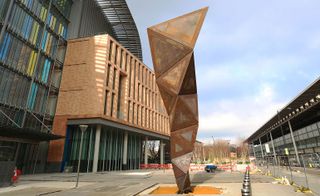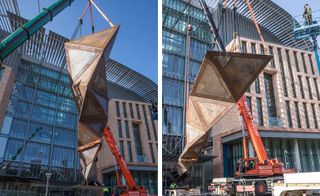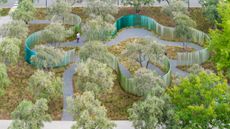Conrad Shawcross unveils imposing new sculpture for The Francis Crick Institute

The British artist Conrad Shawcross has unveiled a daring, and rather disconcerting, public sculpture for London’s major new centre of science. At an imposing 14m tall, it’s a confident and beautiful piece, at once a triumph of engineering and a totem to the limits of knowledge.
Commissioned by Europe’s largest biomedical research centre, The Francis Crick Institute, it now stands in front of their brand new glass and steel megalab in St Pancras. The artwork, chosen by the Nobel Prize-winning director of the Crick, Sir Paul Nurse, is called Paradigm – a nod to the scientific philosopher Thomas Kuhn who believed that in order for ideas to progress, old paradigms should be toppled by the new.
Comprised of an angular, twisting stack of tetrahedral blocks made of weathering steel, it’s one of London’s largest tallest art works. While this is a statement of confidence, Shawcross says he wanted it to point to the fragility of engineering, and the boundaries of science. The base of the work is only one metre wide, and the tetrahedron shapes get 10 per cent bigger as they go up. 'If you added another it would collapse,' Shawcross says, rather ominously.
Shawcross describes the work as, 'a beacon for progress and endeavour but contains fallibility and should serve as a constant reminder of the precariousness of knowledge'. The artist has always been interested in the way artists define themselves in relation to technology; when the National Gallery asked him to produce a work in response to Titian for the Cultural Olympiad in 2012, he presented the institution with a dancing robot.
At 39, Shawcross is the youngest of the artist-elected Royal Academicians. His work has a broad appeal owing to its classical and mathematical rigour – often investigating idealised geometry and proportion – and he currently has a good claim to being London’s best-loved public sculptor. Last summer his work Three Perpetual Chords, 'a visual realisation of a particular harmonic ratio', permanently replaced a stolen Barbara Hepworth in Dulwich Park, South London; also in 2015, his work The Dappled Light of the Sun, a five-tonne canopy made from thousands of steel tetrahedrons, was the largest ever sculpture to fill the Royal Academy’s courtyard. Later this year, he will unveil a work commissioned for the Low Carbon Energy Centre on the Greenwich Peninsula – all of which will be revealed in our forthcoming issue April issue, out 10 March.

The artwork, chosen by the Nobel Prize-winning director of the Crick, Sir Paul Nurse, now stands in front of its brand new glass and steel megalab in St Pancras. Courtesy the Francis Crick Institute

The work is called Paradigm – a nod to the scientific philosopher Thomas Kuhn who believed that in order for ideas to progress, old paradigms should be toppled by the new. Courtesy the Francis Crick Institute. Photography right: Marc Wilmot

Shawcross describes the work as, 'a beacon for progress and endeavour but contains fallibility and should serve as a constant reminder of the precariousness of knowledge'.
Wallpaper* Newsletter
Receive our daily digest of inspiration, escapism and design stories from around the world direct to your inbox
-
 Don’t Move, Improve 2024: London’s bold, bright and boutique home renovations
Don’t Move, Improve 2024: London’s bold, bright and boutique home renovationsDon’t Move, Improve 2024 reveals its shortlist, with 16 home designs competing for the top spot, to be announced in May
By Ellie Stathaki Published
-
 Perfumer H has bottled the scent of dandelions blowing in the wind
Perfumer H has bottled the scent of dandelions blowing in the windPerfumer H has debuted a new fragrance for spring, called Dandelion. Lyn Harris tells Wallpaper* about the process of its creation
By Hannah Tindle Published
-
 The best fashion moments at Milan Design Week 2024
The best fashion moments at Milan Design Week 2024Scarlett Conlon discovers the moments fashion met design at Salone del Mobile and Milan Design Week 2024, as Loewe, Hermès, Bottega Veneta, Prada and more staged intriguing presentations and launches across the city
By Scarlett Conlon Published
-
 Peter Blake’s sculptures spark joy at Waddington Custot in London
Peter Blake’s sculptures spark joy at Waddington Custot in London‘Peter Blake: Sculpture and Other Matters’, at London's Waddington Custot, spans six decades of the artist's career
By Hannah Silver Published
-
 Oozing, squidgy, erupting forms come alive at Hayward Gallery
Oozing, squidgy, erupting forms come alive at Hayward Gallery‘When Forms Come Alive: Sixty Years of Restless Sculpture’ at Hayward Gallery, London, is a group show full of twists and turns
By Hannah Silver Published
-
 Conrad Shawcross plays with the dimensions of time for Royal Salute
Conrad Shawcross plays with the dimensions of time for Royal SaluteTime Chamber, a new work by Conrad Shawcross for Royal Salute, is the second edition in the brand’s Art of Wonder collection
By Henrietta Thompson Published
-
 New glass sculpture creates a verdant wonderland at Apple’s Cupertino HQ
New glass sculpture creates a verdant wonderland at Apple’s Cupertino HQ‘Mirage’ at Apple Park is the work of Zeller & Moye and artist Katie Paterson, a shimmering array of glass columns that snakes through the grounds of the company’s monumental HQ
By Jonathan Bell Published
-
 Man Ray’s sculptures go on show in New York
Man Ray’s sculptures go on show in New York‘Man Ray: Other Objects’ opens at Luxembourg + Co, New York, revealing their author’s ‘artistic revolution’
By Hannah Silver Published
-
 The best London art exhibitions to see now
The best London art exhibitions to see nowYour guide to the best London art exhibitions, as chosen by the Wallpaper* arts desk
By Hannah Silver Published
-
 Erwin Wurm’s pop-coloured fantasy land at Yorkshire Sculpture Park
Erwin Wurm’s pop-coloured fantasy land at Yorkshire Sculpture ParkIn Erwin Wurm’s first UK museum show, ‘Trap of the Truth’, the artist transforms Yorkshire Sculpture Park into a slightly warped wonderland (10 June 2023 – 28 April 2024)
By Harriet Lloyd-Smith Published
-
 Sculptor Arnaldo Pomodoro transforms Fendi’s Rome HQ into a theatre of myth and magic
Sculptor Arnaldo Pomodoro transforms Fendi’s Rome HQ into a theatre of myth and magicFendi’s Roman HQ sets the scene for ‘Il Grande Teatro delle Civiltà’ a major show by Italian sculptor Arnaldo Pomodoro, who has also created a one-off edition of the house’s iconic Peekaboo bag. Read more in the July 2023 Issue of Wallpaper*, on newsstands 8 June
By Harriet Lloyd-Smith Published